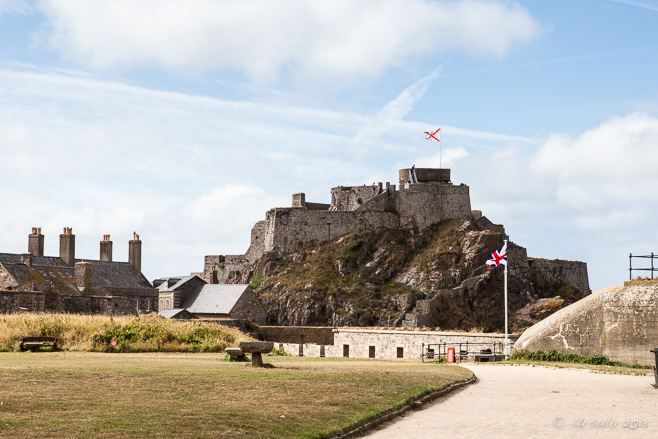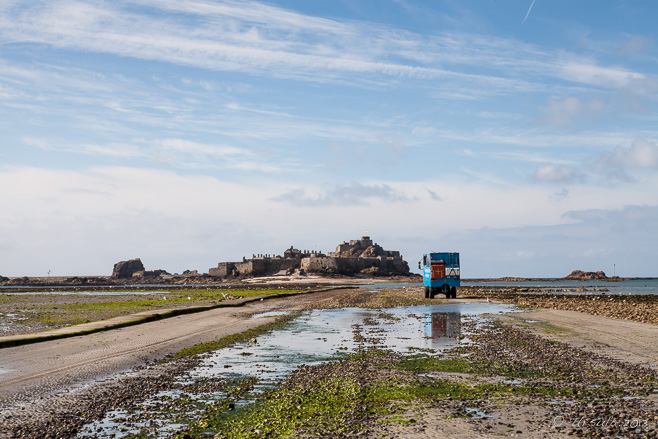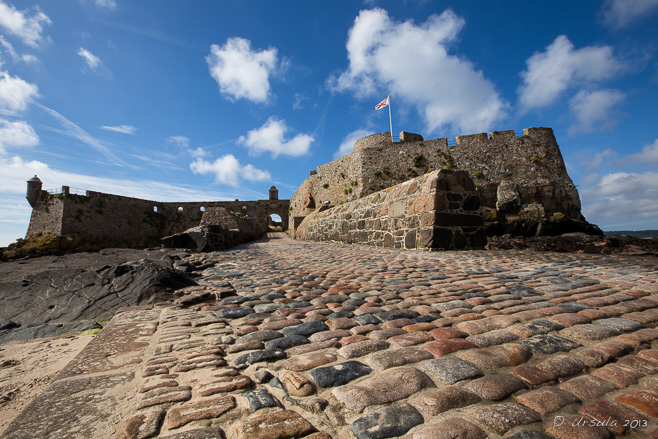
Flying the Flags
The Jersey flag flies high over Elizabeth Castle, while the Union Jack presides over the courtyard.
Jersey, the southern-most of the Channel Islands, packs a lot of history into a tiny space.
Much of this history is because of the island’s strategic location: only 12 nautical miles (22 km; 14 mi) from France. Functionally part of the United Kingdom since the Norman conquest of England under William the Conqueror in 1066, this little island in the English Channel has been an integral player in the ongoing European border disputes since that time.
Elizabeth Castle, built in the late 1500s to protect the island against the threat of French invasion, is a good example. The castle’s pedigree is like something out of a Masterpiece Theatre Historical Drama: the fortification was named for the Tudor English Queen, Elizabeth I, by the infamous explorer and courtier, Sir Walter Raleigh, who was Governor of Jersey from 1600 until 1603.
Elizabeth Castle was built on a rocky, tidal islet in St Aubin’s Bay – the same islet that was reputedly once home to the sixth century hermit and martyr, St Helier. The castle replaced Jersey’s original principal defensive structure, Mont Orgueil Castle, which had been built high over the harbour of Gorey in the early 1200s. That castle became indefensible, however, with the development of gunpowder and the possibility of ships with cannons attacking the growing city of St Helier.
King Charles II took refuge in the Governor’s House at Elizabeth Castle during the English Civil War; French prisoners were kept on the island during the Seven Years’ War; and the German occupying forces re-fortified the bunkers during the World War II.

Causeway to Elizabeth Castle
At low tide you can walk from St Helier, Jersey’s capital, to the rocky islet in St Aubin’s Bay – or you can make a crossing in one of the amphibious ferries at any tide.

Cobbled Slipway
A steep slipway climbs up to the main gate, Elizabeth Castle.

Hospital Building
A two-story barracks hospital building, constructed in the early 19th century, stands outside the main bastion.

Crests on the Wall
The battlements around the castle date back to the 1590s.

Flowers on the Corner

Through the Arch to St Aubin’s Bay

Guard Turret

Elizabeth Castle, the Cannon Battery, and the Barracks

Rocky Shore
The hill over the Grand Battery affords views back to St Helier.

Visitor Resting in the Grand Battery

Cannons along the Grand Battery
Some of the old cannons in the castle are maintained and are still in use; there is a demonstration of the firing daily.

Cannon Insignia
Elizabeth Castle was built at a time when cannon fire was the main threat during warfare.

View from Below
Looking up to the top of the castle where the Jersey flag flies against a rainy sky.

Parade Ground
The old barracks, first built in the mid-1600s, now house museums on War and Peace; Granite and Gunpowder; and Militia.

“Invaded”
Inside one of the exhibits, a 2012 Jersey Heritage ‘newspaper’ is displayed. It is written as if it were a contemporaneous account (6 January 1781) of the Battle of Jersey. The French invading force was attempting to remove the British threat to French shipping during the American Revolutionary War.

Weeds on the Roof
The old buildings host some wonderful colours and textures.

Window in the Wall
Looking back towards the city of St Helier.

Grated Window
Looking towards St Helier’s Hermitage.

View from the Castle
It’s an impressive – if breezy – view over St. Aubin’s Bay from the top of the castle.

Buildings at the Back
Behind the barracks, the stairs in the wall lead down to the hermitage and the breakwater.

Weeds on the Wall

The Hermitage Rock
The back of St Helier’s Hermitage and Elizabeth Castle can be viewed from the breakwater.

The Hermitage
The steps up to “St. Helier’s Bed”, the hollow in the rock where the ascetic hermit Helier sheltered, are steep and slippery. Helier was martyred in 555 AD, and the stone medieval chapel was built soon afterward. Pilgrims still visit annually on July 16.

Elizabeth Castle from the Back

Captains Quarters
Working our way back through the barracks, we go through re-constructed residences…

Sergeant at Arms
… arriving at the Parade Ground in time for a fire-arm talk and demonstration by a “Sergeant at Arms”.

Jersey Cow
The island’s eponymous cow is well represented in the gift shop…

Main Gate and Ticket Office
… which we check out quickly …

“Charming Nancy”
… before we catch one of the amphibious ferries back to the city.

That’s how I like my history: in a form I can wander around, climb over, and poke into.
It’s like a ramble into the past – and Jersey sure has a fascinating past.
Photos: 31August2013

































.png)


It was a great day out and yes very breezy. Very interesting place for anyone to visit.
[…] the development of gunpowder and cannon-shot made it’s position untenable. In the 1500s, Elizabeth Castle, built on Jersey’s south coast, replaced Gorey Castle in strategic importance (see: […]